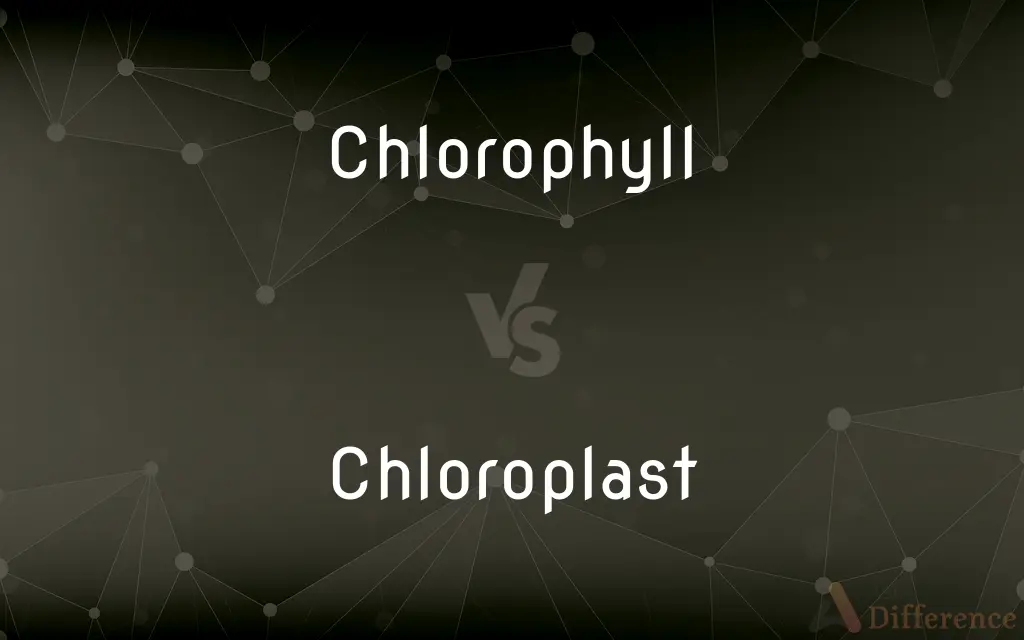Chlorophyll vs. Chloroplast — What's the Difference?
By Tayyaba Rehman & Maham Liaqat — Updated on April 18, 2024
Chlorophyll is a pigment that absorbs light for photosynthesis, predominantly green and found within the chloroplasts of plants, whereas chloroplasts are organelles conduct photosynthesis, containing chlorophyll and other pigments within their structure.

Difference Between Chlorophyll and Chloroplast
Table of Contents
ADVERTISEMENT
Key Differences
Chlorophyll is the pigment responsible for capturing light energy, which is crucial for the photosynthesis process, turning light energy into chemical energy. Chloroplasts, on the other hand, are specialized compartments within plant cells where photosynthesis actually takes place, housing chlorophyll and other components necessary for the process.
Chlorophyll primarily absorbs light in the blue and red wavelengths but reflects green, which is why plants appear green. In contrast, chloroplasts are complex structures that, besides chlorophyll, contain various enzymes and molecules involved in the conversion of light energy into glucose.
While chlorophyll's role is specific to the absorption of light, chloroplasts perform several functions related to photosynthesis, including carbon fixation and oxygen production. This makes chloroplasts integral to both the light-dependent and light-independent reactions of photosynthesis.
Chlorophyll is a molecule contained within the thylakoid membranes of the chloroplast. The chloroplast itself is a larger organelle with an outer membrane, an inner membrane, and internal structures such as thylakoids and stroma, which are essential for its photosynthetic functions.
In terms of evolutionary biology, chlorophyll is found across various photosynthetic organisms, including algae and certain bacteria, indicating its fundamental role in photosynthesis. Chloroplasts, however, are specific to eukaryotic cells and are believed to have originated from cyanobacteria through a process called endosymbiosis.
ADVERTISEMENT
Comparison Chart
Definition
A pigment that absorbs light for photosynthesis
An organelle where photosynthesis occurs
Function
Light absorption
Photosynthesis including carbon fixation
Location
Inside the chloroplasts, within thylakoid membranes
In the cytoplasm of plant and algal cells
Composition
Chlorophyll a and b are the most common types
Contains chlorophyll, enzymes, DNA, and ribosomes
Visual Appearance
Green pigment
Green, typically lens-shaped organelle
Compare with Definitions
Chlorophyll
Exists mainly in two forms, chlorophyll a and b, which absorb different wavelengths of light.
Chlorophyll a absorbs mainly blue and red light, crucial for deep light penetration in water.
Chloroplast
Contains chlorophyll, enzymes, and its own DNA, which suggests its evolutionary origin as a symbiotic bacterium.
Chloroplast DNA is similar to bacterial DNA, supporting the endosymbiotic theory.
Chlorophyll
A green pigment vital for photosynthesis, absorbing light energy.
Chlorophyll gives leaves their green color and is essential for plant energy production.
Chloroplast
Structured with an inner and outer membrane, stroma, and thylakoids.
The stroma of the chloroplast is where the Calvin cycle occurs, fixing carbon into sugars.
Chlorophyll
Chlorophyll molecules are located within the thylakoid membranes of chloroplasts.
Thylakoid membranes are stacked within chloroplasts to maximize light absorption.
Chloroplast
A cellular organelle found in plants and algae that performs photosynthesis.
Chloroplasts are what enable plants to convert light energy into chemical energy.
Chlorophyll
Integral to converting solar energy into chemical energy.
Chlorophyll captures sunlight to initiate the process of photosynthesis, converting it into usable energy in the form of glucose.
Chloroplast
Can replicate independently within plant cells and often move within cells to maximize light exposure.
Chloroplasts position themselves along cell walls perpendicular to light sources to absorb maximum light.
Chlorophyll
Found in all photosynthetic organisms including algae and certain prokaryotes.
Even cyanobacteria contain chlorophyll, which aids in their photosynthetic processes.
Chloroplast
Plays a critical role in the global carbon cycle through the process of photosynthesis.
Chloroplasts in oceanic algae contribute significantly to carbon fixation, impacting global climate patterns.
Chlorophyll
Chlorophyll (also chlorophyl) is any of several related green pigments found in the mesosomes of cyanobacteria and in the chloroplasts of algae and plants. Its name is derived from the Greek words χλωρός, khloros ("pale green") and φύλλον, phyllon ("leaf").
Chloroplast
Chloroplasts are organelles that conduct photosynthesis, where the photosynthetic pigment chlorophyll captures the energy from sunlight, converts it, and stores it in the energy-storage molecules ATP and NADPH while freeing oxygen from water in plant and algal cells. They then use the ATP and NADPH to make organic molecules from carbon dioxide in a process known as the Calvin cycle.
Chlorophyll
A waxy blue-black microcrystalline green-plant pigment, C55H72MgN4O5, with a characteristic blue-green alcohol solution. Also called chlorophyll a.
Chloroplast
A plastid that contains chlorophyll and is found in the cells of green plants and algae.
Chlorophyll
A similar green-plant pigment, C55H70MgN4O6, having a brilliant green alcohol solution. Also called chlorophyll b.
Chloroplast
(cytology) An organelle, found in the cells of green plants and in photosynthetic algae, where photosynthesis takes place, characterized by a high concentration of chlorophyll and two membranes.
Chlorophyll
(biochemistry) Any of a group of green pigments that are found in the chloroplasts of plants and in other photosynthetic organisms such as cyanobacteria.
Chloroplast
A plastid containing chlorophyll, developed only in cells exposed to the light. Chloroplasts are minute flattened granules, usually occurring in great numbers in the cytoplasm near the cell wall, and consist of a colorless ground substance saturated with chlorophyll pigments. Under light of varying intensity they exhibit phototactic movements. In animals chloroplasts occur only in certain low forms.
Chlorophyll
Literally, leaf green; a green granular matter formed in the cells of the leaves (and other parts exposed to light) of plants, to which they owe their green color, and through which all ordinary assimilation of plant food takes place. Similar chlorophyll granules have been found in the tissues of the lower animals.
Chloroplast
Plastid containing chlorophyll and other pigments; in plants that carry out photosynthesis
Chlorophyll
Any of a group of green pigments found in photosynthetic organisms. Chlorophyll a and chlorophyll b are found in higher plants and green algae; chlorophyll c is found in certain types of marine algae. Chemically, it has a porphyrin ring with a magnesium ion bound to the four central nitrogens, and has a phytyl side chain. It is essential for photosynthesis in most plants. Chlorophyll a has formula C55H72N4O5Mg.
Chlorophyll
Any of a group of green pigments found in photosynthetic organisms
Common Curiosities
Why are chloroplasts important in the study of evolutionary biology?
The presence of their own DNA and the similarity to bacterial DNA in chloroplasts provide evidence for the theory of endosymbiosis, suggesting that eukaryotic cells evolved from symbiotic relationships with bacteria.
What is the main role of chloroplasts in plant cells?
Chloroplasts conduct photosynthesis, producing glucose for energy and oxygen as a byproduct, essential for plant growth and oxygenation of the environment.
Can chloroplasts be found in non-green parts of a plant?
Yes, chloroplasts can be present in non-green parts, such as roots, but they often lack chlorophyll and perform different functions related to energy storage.
Can chlorophyll exist outside of chloroplasts?
While chlorophyll is typically housed within chloroplasts, it can be found in other photosynthetic membranes in various organisms.
What is the primary function of chlorophyll in photosynthesis?
Chlorophyll absorbs light energy, which is crucial for converting carbon dioxide and water into glucose and oxygen.
What happens if a plant cell lacks chlorophyll?
Without chlorophyll, a plant cannot perform photosynthesis, which typically results in a condition called chlorosis, leading to reduced growth and vitality.
How does the structure of a chloroplast facilitate its function?
The structural components of chloroplasts, such as the double membrane and internal thylakoid stacks, enhance their efficiency in capturing light and performing photosynthesis.
How do chloroplasts contribute to plant adaptation?
Chloroplasts can move within cells and adjust their orientation to maximize light absorption, aiding in plant adaptation to varying light conditions.
What is the significance of chlorophyll b?
Chlorophyll b assists chlorophyll a in capturing light energy and extends the range of light wavelengths a plant can use for photosynthesis.
How does chlorophyll interact with other pigments in chloroplasts?
Chlorophyll works alongside other pigments like carotenoids and xanthophylls, which help in light absorption and protect chlorophyll from photo-damage.
Share Your Discovery

Previous Comparison
Lake vs. River
Next Comparison
Net vs. LetAuthor Spotlight
Written by
Tayyaba RehmanTayyaba Rehman is a distinguished writer, currently serving as a primary contributor to askdifference.com. As a researcher in semantics and etymology, Tayyaba's passion for the complexity of languages and their distinctions has found a perfect home on the platform. Tayyaba delves into the intricacies of language, distinguishing between commonly confused words and phrases, thereby providing clarity for readers worldwide.
Co-written by
Maham Liaqat













































